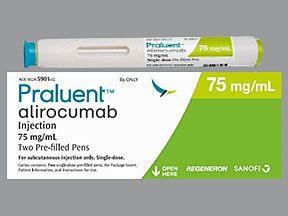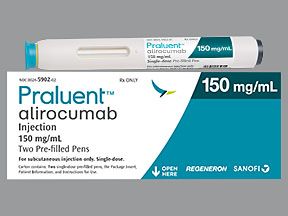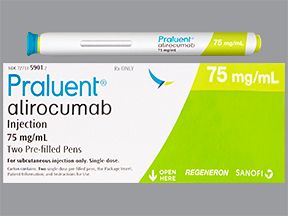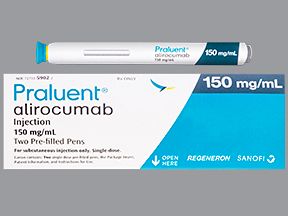If you have high cholesterol or cardiovascular disease (disease of the heart and blood vessels), your doctor may recommend treatment with Praluent. It’s a prescription drug used for:
- lowering low-density lipoprotein (LDL) cholesterol in certain adults with:
- primary hyperlipidemia, including heterozygous familial hypercholesterolemia
- homozygous familial hypercholesterolemia
- lowering the risk of heart attack, stroke, and unstable angina (a type of chest pain) in adults with cardiovascular disease
To learn more about these conditions and how Praluent helps treat them, see the “What is Praluent used for?” section below.
Praluent basics
Praluent is given as an injection under your skin. Praluent contains the active drug alirocumab, which is a biologic medication. A biologic is made from parts of living organisms.
Praluent contains the active ingredient* alirocumab. This drug isn’t available in a biosimilar form. (Biosimilars are like generic drugs. But unlike generics, which are made for non-biologic drugs, biosimilars are made for biologic drugs.) Instead, alirocumab is only available as the brand-name drug Praluent.
Praluent belongs to a group of medications called PCSK9 inhibitors.
Keep reading to learn about Praluent’s side effects, uses, dosages, and more.
* An active ingredient is what makes a drug work.
Like most drugs, Praluent may cause mild or serious side effects. The lists below describe some of the more common side effects that Praluent may cause. These lists don’t include all possible side effects.
Keep in mind that the side effects of a drug can depend on:
- your age
- other health conditions you have
- other medications you take
Your doctor or pharmacist can tell you more about the potential side effects of Praluent. They can also suggest ways to help reduce side effects.
Mild side effects
Here’s a short list of some of the mild side effects that Praluent can cause. To learn about other mild side effects, talk with your doctor or pharmacist, or read Praluent’s prescribing information.
Mild side effects of Praluent that have been reported include:
- common cold symptoms, such as a runny nose, sneezing, and sore throat
- flu-like symptoms, such as body aches, fatigue (low energy), and fever
- urinary tract infection (UTI)
- diarrhea
- cough
- muscle spasm (muscle cramps)
- blocked sinuses, which may cause headache or pain in your face
- bruising
- muscle pain*
- injection site reaction*
Mild side effects of many drugs may go away within a few days to a couple of weeks. But if they become bothersome, talk with your doctor or pharmacist.
* For more information about this side effect, see the “Side effect focus” section below.
Serious side effects
Serious side effects from Praluent can occur, but they aren’t common. If you have serious side effects from Praluent, call your doctor right away. But if you think you’re having a medical emergency, you should call 911 or your local emergency number.
Serious side effects of Praluent that have been reported include:
* For more information about this side effect, see the “Side effect focus” section below.
Side effect focus
Learn more about some of the possible side effects of Praluent.
Muscle pain
It’s possible that you’ll have muscle pain as a side effect of treatment with Praluent.
This side effect wasn’t very common in studies. It’s important to point out that many people who took Praluent in these studies were also taking a statin medication (a different type of drug used to lower cholesterol). Statins can also cause muscle pain as a side effect.
What might help
If you have muscle pain while taking Praluent, tell your doctor. They may be able to suggest ways to treat or ease your side effects. If you have muscle pain that doesn’t go away or is bothersome to you, they may recommend that you stop taking Praluent.
Injection site reaction
Injection site reaction is a possible side effect of Praluent. This is a side effect at the area where you inject a Praluent dose. An injection site reaction caused by Praluent can include itching, pain, redness or discoloration, swelling, and tenderness.
In studies, injection site reaction was among the most common side effects of Praluent. People who took a 300-milligram (mg) dose every 4 weeks were more likely to have an injection site reaction than people who took a 150-mg dose every 2 weeks.
What might help
To help prevent an injection site reaction, you should rotate injection sites with each dose. You should also avoid giving injections into skin that appears red or discolored, tender, hard, or injured. (See the “How is Praluent administered?” section below for details.)
If injection site reactions are bothersome to you or keep happening, tell your doctor. They’ll likely suggest you stop taking Praluent, and they can discuss other treatments for your condition.
High liver enzyme levels
Treatment with Praluent may cause high liver enzyme levels as a side effect. This wasn’t common in studies, though.
High liver enzyme levels don’t cause symptoms in most people. But they are sometimes a sign of liver damage.
Liver damage can cause symptoms such as:
- dark urine
- nausea and vomiting
- jaundice (yellowing of the skin or whites of the eyes)
- loss of appetite
There was no serious liver damage or liver injury reported in studies of Praluent. People with preexisting severe liver problems weren’t included in these studies, though. It isn’t known whether having existing liver problems can increase your risk of liver problems with Praluent.
What might help
While you’re taking Praluent, your doctor may monitor your liver enzyme levels using blood tests. Your doctor can give you more information on how often you’ll have these tests while you’re taking Praluent.
If you have symptoms of liver damage during treatment with Praluent, tell your doctor right away. They can advise if it’s safe for you to continue with Praluent treatment.
Allergic reactionSome people may have an allergic reaction to Praluent. Mild allergic reactions were common in studies.
Symptoms of a mild allergic reaction can include:
- skin rash
- itchiness
- flushing (temporary warmth, redness, or deepening of skin color)
A more severe allergic reaction is rare but possible. Symptoms of a severe allergic reaction can include swelling under your skin, typically in your eyelids, lips, hands, or feet. They can also include swelling of your tongue, mouth, or throat, which can cause trouble breathing.
Call your doctor right away if you have an allergic reaction to Praluent. But if you think you’re having a medical emergency, call 911 or your local emergency number.
Praluent and Repatha are prescription drugs that are very similar to each other.
Both belong to the same group of drugs, called PCSK9 inhibitors. Praluent and Repatha both come as a liquid solution that’s given as an injection under your skin. They have some of the same uses, and some different ones as well.
To learn more about how Praluent compares with Repatha, see this side-by-side breakdown. You can also talk with your doctor about which drug is right for you.
The cost of prescription drugs can vary depending on many factors. These factors include what your insurance plan covers and which pharmacy you use.
If you have questions about how to pay for your prescription, talk with your doctor or pharmacist. You can also visit the Praluent manufacturer’s website to see if they have support options or patient assistance.
You can also check out this article to learn more about saving money on prescriptions.
Your doctor will recommend the dosage of Praluent that’s right for you. Below are commonly used dosages, but always take the dosage your doctor prescribes.
Form and strengths
Praluent comes as a liquid solution in a prefilled, single-dose pen. You’ll take Praluent as an injection under your skin.
Praluent pens are available in two strengths:
- 75 milligrams per milliliter of solution (75 mg/ml)
- 150 mg/ml
Recommended dosages
The Praluent dosage your doctor prescribes, including the dosing frequency, will depend on the condition you’re taking Praluent for. Your doctor might prescribe either biweekly (every 2 weeks) or monthly dosing. For example, you might take 300 mg once every month.
Your doctor may adjust your dosage based on how your cholesterol levels respond to treatment.
Note: If you have homozygous familial hypercholesterolemia, or if you’re also having low-density lipoprotein (LDL) apheresis treatment, you’ll likely take Praluent every 2 weeks.
Questions about Praluent’s dosage
- What if I miss a dose of Praluent? If you miss a Praluent injection and it’s been less than 7 days, take your injection and then continue with your regular dosing schedule. If it’s been more than 7 days since the missed dose, what you should do depends on how often you take Praluent:
- If you take Praluent biweekly, skip the missed dose and take your next dose on its scheduled date.
- If you take Praluent every 4 weeks, take the missed dose, then start a new dosing schedule based on this date. Your doctor or pharmacist can help with this, if needed.
- Will I need to take Praluent long term? Praluent is meant to be a long-term treatment, if you and your doctor agree that it’s working well for you.
- How long does Praluent take to work? Praluent begins working as soon as you take a dose. But it may be several weeks before you notice a difference in your LDL cholesterol levels on blood tests.
Find answers to some commonly asked questions about Praluent.
How does Praluent work? What’s its half-life and how long does it stay in your system?
Praluent works by blocking the action of an enzyme (a type of protein) called PCSK9. This allows your liver to remove more low-density lipoprotein (LDL) cholesterol from your body.
LDL cholesterol is known as “bad” cholesterol. By lowering levels of this cholesterol, Praluent can reduce the risk of certain cardiovascular problems (problems of the heart and blood vessels). See “How is Praluent used?” for details.
Praluent’s half-life is about 17 to 20 days. A drug’s half-life is how long it takes to get rid of half of a dose. This means Praluent typically stays in your system for about 100 days after an injection.
If you’re also taking a statin (a type of cholesterol drug), Praluent might leave your system a few days sooner than this. Taking it with a statin doesn’t affect how well Praluent works, though.
If you have more questions about how Praluent works in your body, talk with your doctor or pharmacist.
Will Praluent cause weight gain or weight loss?
Neither weight gain nor weight loss were reported by people taking Praluent in studies.
Keep in mind that Praluent is often prescribed along with other drugs, including drugs used to lower cholesterol. These other medications may affect your weight. Your doctor or pharmacist can review your medications and check for any that can cause weight changes.
When prescribed to lower LDL cholesterol, Praluent should be taken along with a balanced diet and regular exercise. Otherwise, the medication may not work. Talk with your doctor about ways to reach or maintain a weight that’s healthy for you.
How should I store Praluent?
You should store Praluent pens in the refrigerator, at a temperature between 36°F and 46°F (2°C to 8°C). Do not store them in the freezer.
You may also store Praluent pens in their original carton at room temperature (about 77°F, or 25°C) for up to 30 days. Be sure to keep the carton away from light.
You should dispose of any unused pens after 30 days, even if they still have medication in them. Praluent pens should be thrown away into a
Talk with your pharmacist or doctor if you have questions about storing Praluent.
Does Praluent lower triglycerides?
This is possible. Praluent isn’t approved to treat high levels of triglycerides (a type of fat that’s released into your blood for energy between meals). It’s also not approved to treat mixed hyperlipidemia (high cholesterol and triglyceride levels).
But in one
If you have questions about your triglyceride levels or your treatment plan, talk with your doctor or pharmacist.
How does Praluent compare with statins?
Statins are a group of medications prescribed to treat high cholesterol, which Praluent is also prescribed to treat. Like Praluent, some statins are also prescribed to lower the risk of heart attack and stroke in adults with cardiovascular disease.
Praluent and statins can cause some of the same side effects. These include common cold symptoms, nausea, diarrhea, and muscle pain. Some statins can also cause joint pain, which wasn’t reported in studies of Praluent.
A major difference between Praluent and statins is how the drugs are given. Praluent comes as a liquid solution that you inject under your skin every 2 or 4 weeks. Statins come as tablets or capsules that you swallow, and most are taken daily.
If you’d like to learn more about how Praluent and statins compare, talk with your doctor or pharmacist.
Can Praluent cause memory loss?
No, memory loss wasn’t reported in studies of Praluent.
Praluent is often prescribed with statins. Rarely, memory loss and other problems with cognition (mental processes such as thinking and understanding) have been reported in people taking statins.
In addition to memory loss, these other problems included confusion and forgetfulness. These problems usually go away a few weeks after stopping statin treatment.
If you have questions or concerns about memory loss and your treatment plan, talk with your doctor or pharmacist.
Below are some important things to discuss with your doctor when considering treatment with Praluent.
Interactions
Taking a medication with certain vaccines, foods, and other things can affect how the medication works. These effects are called interactions.
Praluent isn’t known to interact with any foods, medications, supplements, or herbs. But it’s important to tell your doctor about all the drugs you take before starting Praluent treatment. This includes over-the-counter medicines, vitamins, herbs, and supplements. And keep them up to date on all medications you take. This helps your doctor make sure your treatment plan is safe and works for you.
Warnings
Praluent may not be right for you if you have certain medical conditions or other factors that affect your health.
If you’ve had an allergic reaction to Praluent or any of its ingredients, your doctor will likely not prescribe Praluent. This is known as a contraindication (a factor or condition that prevents your doctor from prescribing a drug due to risk of harm). Ask your doctor what other medications are better options for you.
Praluent and alcohol
Praluent isn’t known to interact with alcohol.
It’s important to note that drinking a lot of alcohol over time can lead to liver damage. And liver problems can be a side effect of Praluent. So drinking alcohol while taking Praluent could increase your risk of liver problems.
Taking Praluent with a statin also increases your risk of liver problems. Praluent is often taken with a statin drug.
If you drink alcohol, talk with your doctor about how much is safe for you to drink while taking Praluent.
Pregnancy and breastfeeding
It’s not known whether Praluent treatment is safe while pregnant. There haven’t been studies of the drug in people who are pregnant. In studies of pregnant animals, Praluent didn’t appear to cause harmful effects. But animal studies don’t always predict what will happen in humans.
If you’re pregnant or planning pregnancy, talk with your doctor. Together you can discuss the risks and benefits of Praluent treatment while pregnant.
It’s not known whether it’s safe to breastfeed while taking Praluent. Talk with your doctor about the risks and benefits of breastfeeding while taking Praluent.
If you have high cholesterol or cardiovascular disease (disease of the heart and blood vessels), your doctor may recommend Praluent. It’s prescribed for use in adults to lower low-density lipoprotein (LDL) cholesterol.
LDL cholesterol is sometimes called “bad” cholesterol. Having high LDL cholesterol levels increases your risk of cardiovascular problems. This is because LDL can build up in your arteries over time. This buildup can reduce blood flow to your heart, which may lead to heart attack or stroke.
Praluent can be used to treat:
- Primary hyperlipidemia (a type of high cholesterol), including heterozygous familial hypercholesterolemia (HeFH). HeFH is a genetic condition that causes high cholesterol. For this use, Praluent may be prescribed by itself or with other cholesterol-lowering drugs. And it’s prescribed with a healthy diet and exercise.
- Homozygous familial hypercholesterolemia (HoFH), another genetic condition that causes high cholesterol. For this use, Praluent is prescribed along with other treatments to lower LDL cholesterol.
Praluent is also approved to lower the risk of certain serious problems in people with cardiovascular disease. These problems include heart attack, stroke, and unstable angina (a type of chest pain). Praluent also lowers the risk of needing treatment in a hospital due to these problems.
Praluent lowers LDL cholesterol by blocking the action of an enzyme (a type of protein) called PCSK9. Blocking PCSK9 helps your liver remove more LDL cholesterol from your body. This can lower your risk of serious problems related to cardiovascular disease.
Your doctor will explain how you should take Praluent. They’ll also explain how much to give yourself and how often. Be sure to follow their instructions.
Praluent comes as a liquid solution in a prefilled single-dose pen. You’ll inject the solution under your skin. Before you start treatment, a healthcare professional will show you or a caregiver how to give Praluent injections at home.
The manufacturer of Praluent also has instructions for use and a video that shows you the steps for injecting the drug.
How to inject Praluent
Before injecting a dose, you should remove Praluent from the refrigerator and let it sit at room temperature for 30 to 40 minutes. Do not place the pen in direct sunlight, and do not use a microwave to heat it up.
Look closely at the Praluent solution before each injection. The liquid should be clear with a colorless to pale-yellow appearance. Do not inject Praluent if your liquid solution looks cloudy or discolored or has particles in it.
After giving your injection, dispose of your Praluent pen in a
Praluent injection sites
You can inject Praluent into:
- your belly, at least 2 inches (in) away from your belly button
- the top of your thigh
- your upper arm
You should choose a different injection site for each dose. Rotating injection sites with each dose helps prevent an injection site reaction. This is a possible side effect of Praluent injections.
You should not inject Praluent into skin that’s red or discolored, tender, hard, or injured.
Taking Praluent with other drugs
Praluent may be prescribed by itself or with other drugs, depending on the condition you’re taking it to treat.
For example, Praluent is often prescribed along with statins to treat homozygous familial hypercholesterolemia.
Examples of statins that may be prescribed with Praluent include:
- pravastatin
- atorvastatin (Lipitor)
- rosuvastatin (Crestor)
In addition to statins, Praluent may also be prescribed along with other cholesterol medications. Your doctor or pharmacist can give you more information on your treatment plan, including other medications you may take to treat your condition.
Questions for your doctorYou may have questions about Praluent and your treatment plan. It’s important to discuss all your concerns with your doctor.
Here are a few tips that might help guide your discussion:
- Before your appointment, write down questions such as:
- How will Praluent affect my body, mood, or lifestyle?
- Bring someone with you to your appointment if doing so will help you feel more comfortable.
- If you don’t understand something related to your condition or treatment, ask your doctor to explain it to you.
Remember, your doctor and other healthcare professionals are available to help you. And they want you to get the best care possible. So don’t be afraid to ask questions or offer feedback on your treatment.
Don’t inject more Praluent than your doctor prescribes. For some drugs, doing so can lead to serious side effects.
What to do in case you inject too much Praluent
Call your doctor if you think you’ve injected too much Praluent. You can also call 800-222-1222 to reach the American Association of Poison Control Centers or use its online resource. But if you have severe symptoms, immediately call 911 or your local emergency number. Or, go to the nearest emergency room.
If you have high cholesterol or cardiovascular disease (disease of the heart and blood vessels), you may benefit from treatment with Praluent.
Ask your doctor for information about the risks and benefits of Praluent treatment for your condition. Here are a few questions you can ask:
- What should I expect when starting treatment with Praluent?
- Will I need to keep taking my other cholesterol medications during Praluent treatment?
- How long will I need to take Praluent?
- What types of lab work will I need to have done while I’m taking Praluent? How often will I need to have blood drawn for labs?
You can also learn more about treatment options for high cholesterol by checking out this article.
And, you can sign up for Healthline’s heart health newsletter here.
Q:
Does Praluent cure high cholesterol?
AnonymousA:
No, Praluent won’t cure high cholesterol. There isn’t a known cure for high cholesterol at this time.
But Praluent has been found effective for lowering low-density lipoprotein (LDL) cholesterol in certain adults. The drug is used along with a balanced diet and regular exercise. Praluent works by helping your liver to remove LDL cholesterol from your body.
Praluent keeps working to decrease your LDL cholesterol as long as you take it. But once you stop taking the drug, your liver may not remove as much LDL cholesterol from your body. This can cause your levels of LDL cholesterol to increase again.
If you have questions about how Praluent works to treat high cholesterol, talk with your doctor or pharmacist.
The Healthline Pharmacist TeamAnswers represent the opinions of our medical experts. All content is strictly informational and should not be considered medical advice.Disclaimer: Healthline has made every effort to make certain that all information is factually correct, comprehensive, and up to date. However, this article should not be used as a substitute for the knowledge and expertise of a licensed healthcare professional. You should always consult your doctor or another healthcare professional before taking any medication. The drug information contained herein is subject to change and is not intended to cover all possible uses, directions, precautions, warnings, drug interactions, allergic reactions, or adverse effects. The absence of warnings or other information for a given drug does not indicate that the drug or drug combination is safe, effective, or appropriate for all patients or all specific uses.




